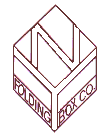The Types of Paperboard
Paperboard is an essential material in our daily lives. Found in packaging, printing, and even construction, it’s a versatile solution that combines functionality with sustainability. With its wide range of types and uses, paperboard stands out as a crucial component in many industries. But what exactly is paperboard, and why is it so important? Let’s dive in.
What Is Paperboard?
Paperboard is a thick, paper-based material. Unlike regular paper, it’s stiffer, more durable, and typically heavier. This makes it perfect for products that need strength without the bulk of other materials like plastic or metal. Its smooth surface also makes it ideal for printing, giving it versatility across multiple industries.
Composition of Paperboard
Paperboard is primarily made from cellulose fibers sourced from wood pulp. Sometimes, other raw materials like recycled fibers are added to boost sustainability. The type and quality of fibers used have a big impact on the paperboard’s strength, weight, and finish. Additives like clay or starch may also be included to improve surface smoothness or water resistance.
Manufacturing Process
The production of paperboard involves several key steps:
Pulping: Wood or recycled paper is broken down into fibers using heat, mechanical action, or chemicals.
Refining: The fibers are processed and blended to achieve the desired characteristics.
Pressing: The fiber mixture is spread onto a screen, pressed, and dried to create sheets of paperboard.
Coating: For certain types, a smooth coating is applied to enhance printability or performance.
This process results in a strong yet lightweight material that serves countless purposes.
Types of Paperboard
Not all paperboard is created equal. Different types cater to various needs, offering unique properties suited to specific applications.
Clay Coated Paperboard
Clay coated paperboard has a smooth surface designed for high-quality printing. The clay coating enhances brightness and creates a polished finish, making it popular for premium packaging and graphic arts. Think of luxury product boxes or glossy product displays—chances are, it’s clay coated paperboard at work.
Common Uses: Product boxes, book covers, and upscale retail packaging.
Solid Bleached Sulfate (SBS)
Solid Bleached Sulfate, or SBS, is made from pure wood pulp and is fully bleached. This gives it a clean white appearance and excellent printability. SBS is FDA-approved for direct food contact, making it a go-to option for food and beverage packaging.
Common Uses: Cereal boxes, ice cream cartons, and medical packaging.
Recycled Paperboard
Recycled paperboard is produced from post-consumer or industrial waste. While it may not have the same strength or smoothness as virgin materials, it’s an eco-friendly choice. Industries often use it when sustainability is a priority over aesthetics.
Common Uses: Folding cartons, backing for notepads, and shoe boxes.
Folding Carton Board
Folding carton board is lightweight yet structurally strong. It’s used for creating carton packaging that can be folded flat for easy transport. Its durability and flexibility make it a staple in the packaging of consumer goods.
Common Uses: Soap boxes, snack packaging, and small electronics containers.
Liquid Packaging Board
Liquid packaging board is designed to hold liquids without leaking. It’s often laminated with a thin layer of plastic or aluminum to improve its barrier properties. This makes it perfect for products like milk, juice, and other beverages.
Common Uses: Milk cartons, juice boxes, and drink pouches.
Applications of Paperboard
Thanks to its versatility, paperboard can be found across various industries, serving a wide range of purposes.
Packaging Solutions
Packaging is by far the largest use of paperboard. Its ability to combine strength, durability, and printability makes it ideal for protecting products while also serving as a marketing tool. Whether it’s a cereal box or a luxury perfume package, paperboard plays an essential role.
Graphic Arts and Printing
Need a surface that can handle vibrant colors and detailed designs? Paperboard’s smooth finish and rigidity make it perfect for printing projects, from greeting cards to product inserts. Designers rely on it to bring their artwork to life in both small and large-scale productions.
Construction and Design Uses
Paperboard’s lightweight nature and adaptability have inspired innovative uses in construction and design. It’s being used to create eco-friendly furniture, temporary structures, and even decorative elements in architecture. With its strength and potential for customization, it’s increasingly being adopted in creative fields.
Environmental Impact of Paperboard
Paperboard stands out as a more sustainable alternative to materials like plastic. However, as with any product, it’s important to weigh both its benefits and challenges.
Eco-Friendly Characteristics
Paperboard is biodegradable and recyclable, which makes it a greener choice compared to non-degradable materials. Many types of paperboard use recycled fibers, reducing the need for raw materials and lowering the carbon footprint of production.
Challenges in Sustainability
While paperboard is generally eco-friendly, its production still requires significant energy and water resources. There’s also the issue of coatings, like plastic or foil laminates, which can complicate recycling. Addressing these challenges is key to making paperboard an even more sustainable option.
Conclusion
Paperboard is an invaluable material with a wide range of applications. From enhancing packaging to supporting sustainable initiatives, it offers countless solutions to modern challenges. Understanding its types—such as clay coated, SBS, and recycled paperboard—helps industries choose the best option for their needs. Plus, its role in sustainability strengthens its position in a world looking for greener solutions.
As technology and environmental awareness continue to grow, paperboard will likely remain a core component across industries. Whether you’re designing packaging or seeking an eco-friendly alternative, it’s clear that paperboard has a lot to offer.
